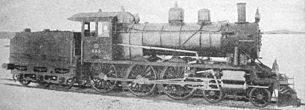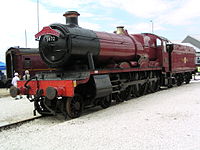
4-6-0
Background Information
SOS Children made this Wikipedia selection alongside other schools resources. A good way to help other children is by sponsoring a child

Under the Whyte notation for the classification of steam locomotives, 4-6-0 represents the wheel arrangement of four leading wheels on two axles in a leading truck, six powered and coupled driving wheels on three axles, and no trailing wheels. This wheel arrangement became the second-most popular configuration for new steam locomotives in America in the mid-19th century. In the United States this type is commonly called a ten-wheeler.
Other equivalent classifications are:
UIC classification: 2C (also known as German classification and Italian classification)
French classification: 230
Turkish classification: 35
Swiss classification: 3/5
United States
The first 4-6-0 built in America was the Chesapeake. It was built by Norris in March 1847 for the Philadelphia and Reading railroad. There is still a question as to who was the original designer of this type. Many authorities attribute the design to Septimus Norris, but in a paper written in 1885, George E. Sellers attributes the design to John Brandt.
Brandt worked for the Erie Railway between 1842 and 1851. The Erie's own management didn't feel it in their best interests to pursue construction, so Brandt showed the design to Baldwin and Norris. Baldwin was similarly unimpressed, but Norris liked the idea. According to Sellers, James Millholland, of the Reading, saw the 4-6-0 design as well and ordered one from Norris for the Reading. However, Sellers may have misrecalled a few of the specifics as Millholland did not work for the Reading until 1848, a year later. Also, Sellers lists the first 4-6-0 constructed as the Susquehanna, which was the Erie railroad's first 4-6-0.
The attribution to Septimus Norris lies in a patent that many sources cite for this locomotive type that was filed in 1846. However, such a patent has not yet been found in searches at the USPTO. Septimus Norris did file a patent in 1854 for running gears, and the patent application showed a 4-6-0 in the drawing. Norris' wording in the 1854 patent was vague in regard to the 4-6-0 wheel arrangement; the filing didn't specifically claim invention of the 4-6-0 type.
A few days after William Norris completed the Chesapeake, Hinkley completed their first 4-6-0, the New Hampshire for the Boston and Maine Railroad. The first 4-6-0 from Rogers was the previously mentioned Susquehanna for the Erie Railroad.
Baldwin's first 4-6-0 did not appear until 1852. Through the 1860s and into the 1870s, demand for the 4-6-0 grew as more railroad executives switched from purchasing a single, general-purpose type of locomotive (at that time, the 4-4-0), to purchasing locomotives for specific purposes. Both the Pennsylvania Railroad and the Baltimore and Ohio (B&O) were early adopters of the 4-6-0, using them for fast freight and heavy passenger trains. One of the B&O's 4-6-0 locomotives, built in 1869, is preserved at the B&O Railroad Museum. Another is at the Museum of Transportation in St. Louis. A third, GN 1355, although built in 1909 as a 4-6-0, underwent a major rebuild in 1924 becoming a 4-6-2, and is in Sioux City, Iowa.
United Kingdom

The first 4-6-0 to be introduced to Britain was the Highland Railway Jones Goods Class in 1894, but the type later mostly found use as mixed traffic and passenger locomotives, British freight trains being generally too slow to require a four-wheel leading truck. The 4-6-0 was particularly suited for these duties since the leading truck gave good stability at speed and allowed a longer boiler to be supported whilst the lack of trailing wheels ensured that a high proportion of the locomotive's weight was put down through the driving wheels, especially when starting a train from rest.
The 4-6-0 enjoyed a brief period of use for the largest express passenger locomotives in Britain as a logical development of the typical 4-4-0 type then in use. Examples include the Caledonian 903 'Cardean' Class (which, on their introduction in 1906 were the most powerful locomotives in Britain), the Great Western 'Star' Class and Great Eastern Class S69. From the 1920s firther demand for more power and performance from express locomotives led to the introduction of 4-6-2 'Pacific' locomotives where the trailing axle could support a larger firebox. The reduced traction of the driving wheels was not such a disadvantage with relatively light passenger trains and the 4-6-0 was displaced from top-rank express services on most railways where they had been used, with the exception of the Great Western Railway which continued to build both mixed-traffic and express 4-6-0s until nationalisation in 1948.
The 4-6-0 arrangement was used by all of the " Big Four" companies, but especially the Great Western Railway and the London, Midland and Scottish Railway, and was used on two of the British Railways standard designs.
Some British 4-6-0 locomotives included:-
- Highland Railway Jones Goods Class, 15 locomotives built in 1894 by Sharp Stewart and Company. One is preserved.
- GWR 2900 ("Saint") Class, 76 locomotives built 1902 - 1913 by GWR Swindon Works.
- GWR 4073 ("Castle") Class, 171 locomotives built 1923 - 1950 by GWR Swindon Works. Eight are preserved.
- GWR 6000 ("King") Class, 30 locomotives built 1927 - 1930 by GWR Swindon Works. Three are preserved.
- LMS 7P Royal Scot, 70 locomotives built 1927 - 1930 by North British and LMS Derby Works. Two are preserved.
- GWR 4900 ("Hall") Class, 259 locomotives built 1928 - 1943 by GWR Swindon Works. Eleven are preserved.
- LMS 6P Patriot, 52 locomotives built 1930 - 1934 by LMS Derby and Crewe Works.
- LMS Stanier Class 5 ("Black Five"), 842 locomotives built 1934 - 1951 by LMS Crewe, Derby, and Horwich Works, Vulcan Foundry, and Armstrong Whitworth. Eighteen are preserved.
- LMS 6P Jubilee, 191 locomotives built 1934 - 1936 by LMS Crewe and Derby Works, and North British.
- GWR 6800 ("Grange") Class, 80 locomotives built 1936 - 1939 by GWR Swindon Works.
- GWR 7800 ("Manor") Class, 30 locomotives built 1938 - 1950 by GWR Swindon Works. Nine are preserved.
- LNER Thompson Class B1, 410 locomotives built 1942 - 1952. Two are preserved.
- GWR 6959 ("Modified Hall") Class, 71 locomotives built 1944 - 1950 by GWR Swindon Works. Seven are preserved.
- GWR 1000 ("County") Class, 30 locomotives built 1945 - 1947 by GWR Swindon Works.
- BR standard class 5, 172 locomotives built 1951 - 1957 by BR Derby and Doncaster Works. Five are preserved.
- BR standard class 4 4-6-0, 80 locomotives built in 1951 by BR Swindon Works. Six are preserved.


